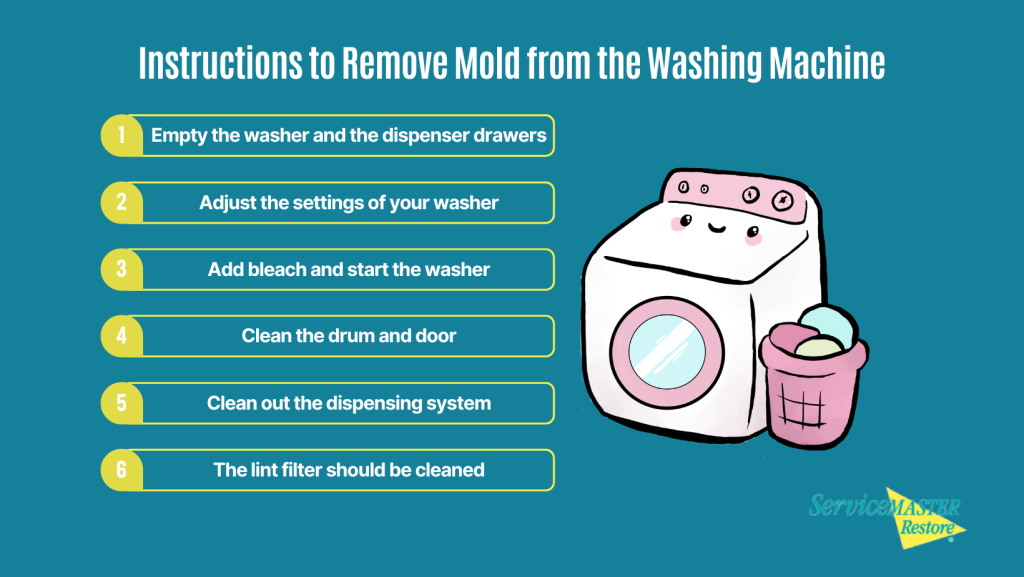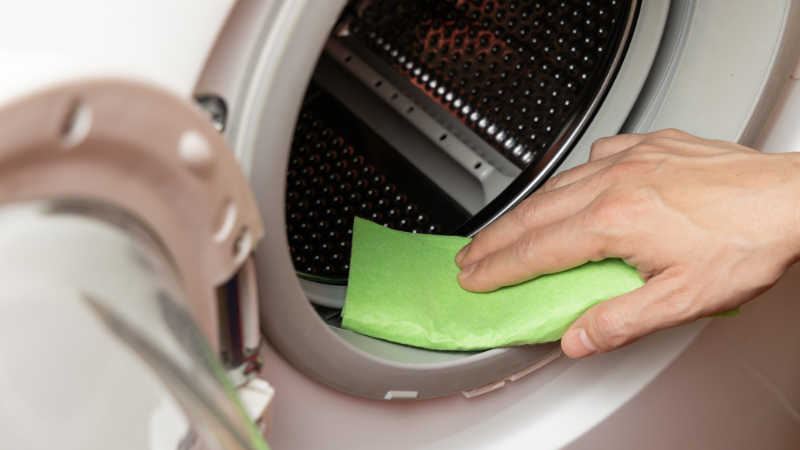To prevent mold in your washing machine, it is important to take proactive steps to stop mold from spreading, such as cleaning the washing machine regularly. The warm, damp environment, combined with bacteria from clothes and detergent residue, creates a perfect breeding ground for mold. When mold forms, it often brings along a bad odor. The most effective way to tackle mold is with bleach, focusing your efforts on the rubber gasket in front-loading machines, detergent dispensers, drainage pipes, and filters. We’ll guide you through using bleach to clean mold from your washing machine and offer tips on maintaining it to prevent future mold issues and avoid costly repairs.
Tools & Materials Needed to Clean Mold from the Washing Machine
To remove mold from your washing machine, you will need these materials:
- A microfiber cloth
- A plastic bucket
- A scrub brush
- Gloves
- Chlorine bleach
Instructions to Remove Mold from the Washing Machine
Make sure to follow these instructions when cleaning your washer to effectively remove mold and prevent it from returning:
- Empty the washer and the dispenser drawers:
To avoid accidentally bleaching your clothes, make sure to empty your washer. If you have an automatic system for dispensing detergent, you should make sure to empty the product as well.
- Adjust the settings of your washer:
Choose a normal wash cycle for a large load so that you can get a proper amount of water to flow through your washer. You can choose the temperature of the water to be warm or hot.
- Add bleach and start the washer:
- Use one cup of bleach in the drum, add ½ a cup of liquid chlorine bleach to the detergent department, and fill the bleach dispenser compartment with bleach.
- Make sure to start the washer and let it complete a full cycle. When you run a cycle with hot water and bleach, it will clean out mold in the drainage lines.
- Please note: If you do not want to use chlorine bleach, you can use one cup of hydrogen peroxide instead.
- Clean the drum and door:
When the cycle is done, use a dry cloth to dry the door and the gaskets. If you have a front load washer, just peel back the door gasket so you can clean the inside. Sometimes the dirt and residue from detergent will get trapped and mold can start growing there. Make sure you wear protective gloves and then using a microfiber cloth, or a brush with soft bristles, dip it into a solution of ¼ cup of chlorine bleach and two cups of water. Once you’ve cleaned all the mold, dry the area with a cloth.
- Clean out the dispensing system:
Make sure to remove the drawers from your dispensing system. If you are unsure how to do so, you should consult the owner’s manual.
- Use hot water to rinse the drawers and get rid of any residue. If there is a lot of buildup, you can fill up your sink with hot water and let them soak for at least 10 minutes. Next, rinse it and allow the drawers to air dry.
- Wearing protective gloves, use a cloth and dip it in chlorine bleach and water solution so you can clean the drawer housing on the washer.
- Put the compartments back where they belong.
- Make sure to replace the dispenser drawer and then run a short cycle while the washing machine is empty so that the system can be flushed.
- The lint filter should be cleaned:
You should regularly clean your lint filter or trap before it starts forming mold or causes an odor. These are the steps to follow:
- Find and remove the filter.
- Remove all the lint with a soft brush and wipe any mold with a cloth that has been dipped into chlorine bleach and water.
- Make sure to rinse the filter well and air dry it before you put the filter back.

How can I prevent mold from forming in my washing machine?
There are many reasons why mold may form in your washing machine, however, there are ways you can prevent it:
- Use the proper amount of detergent
It is important that you do not use too much detergent in your washer as you can end up with residue which contains dirt and bacteria that allows for mold and mildew to form. There are different washer cleaners available on the market such as tablet, powder, and liquid formulas. You should choose the one that works best for you and make sure to follow the directions provided to use the correct amount for the load you are washing.
- Do not use fabric softener:
Fabric softener often leaves a residue in the washing machine, and you can end up with mold growth. Instead of liquid fabric softener, you can use distilled white vinegar which can soften clothes and remove detergent residue.
- Improve ventilation and get rid of humidity:
Make sure to add a fan or an air conditioner to your laundry room which will improve air circulation, and it will also dry the inside of your washer quicker. You can also use a dehumidifier to lower the humidity. Another thing you can do is leave a front-loading washer door open after washing so it can dry from the inside.
- Your washer and dryer should be maintained properly:
Always make sure that the fan for your front load washer is clean works properly. The vent should never be blocked. Also, your dryer vent should be tight and not leaking moist air into your laundry room. After each laundry session use a microfiber cloth to dry the door gasket. You should also run a cleaning cycle in your washer either weekly or monthly as needed.
Professional Mold Removal
Mold can grow anywhere where there is moisture and residue which is why appliances like washing machines are vulnerable. If there is mold in your washing machine, it is important to remove it because it could damage the machine and affect your clothing. Following the steps outlined above will help you effectively remove mold from your washing machine and prevent it from returning. However, if you have a mold problem that you cannot manage yourself, it is best to call our mold remediation specialists.
Our professionals at ServiceMaster DRR provide complete mold remediation services to effectively remove mold from affected areas of your home. We use advanced remediation methods to ensure the compete removal of mold and we can treat appliances like washing machines that have been affected.
Do not hesitate to call us at (800) 439-8833 if you notice a mold issue in your home that requires professional attention.

Steve VanDenBerg is the owner of ServiceMaster Disaster Restoration and Recovery. He has over 30 years of experience working within the restoration industry and successfully leading start-ups, turnarounds, acquisitions and mergers, and rapidly growing companies.
Steve earned his BS in Business & Accounting from Calvin University in Grand Rapids, MI and began working for DSI Holdings as their Chief Financial Officer. When Steve began with DSI Holdings, they were running an underperforming ServiceMaster Restore franchise with one location. Steve implemented new policies and procedures for accounting and finance as well as a professional sales plan that increased profits eightfold over his time as the CFO. He was then promoted to President and CEO and in this time, he expanded the company from two locations with $4M in sales to 12 locations and $45M in sales. DSI Holdings became one of the largest disaster restoration companies in the U.S. and helped with major restoration projects throughout the U.S. and around the world.
Steve purchased ServiceMaster DRR in 2015 when the business was in decline. Drawing on his years of experience in turning around struggling ServiceMaster franchises, Steve overhauled our operations, including finance, sales, and marketing, which led to a quick turnaround. Within Steve’s first 24 months, sales increased by 60 percent. Steve also helped greatly improve our operating margins and established a relationship with California’s largest residential insurance company. Under Steve’s leadership, we have become one of the largest disaster restoration providers in California.
Steve has found great success in turning around struggling and stagnant restoration franchises by changing the business model and strategy, greatly increasing sales and profits. Many of the changes he has implemented have even been adopted by the franchisor into their operating model.



